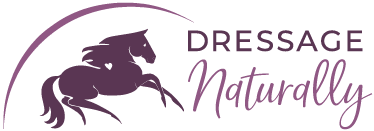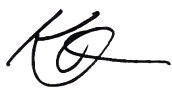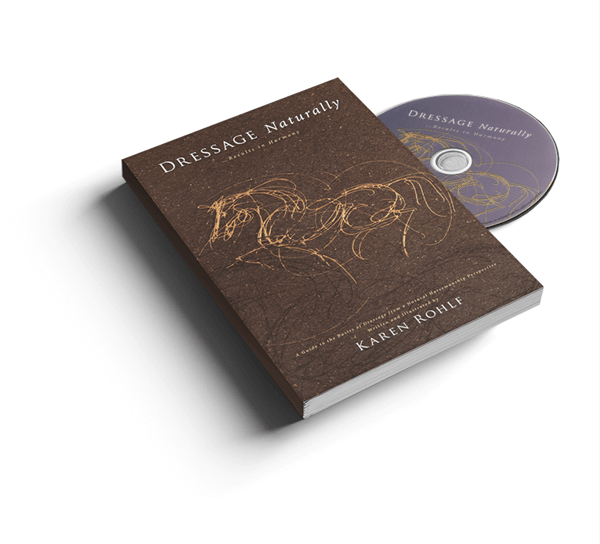Prefer to listen? I did a podcast that includes this subject. You can listen HERE
Can you motivate your horse to offer what you ask of him? It’s a wonderful feeling when you can, but when some people aren’t able to get their horses to perform in the way they desire, they resort to force because they don’t know what else to do. Wouldn’t it be nice to find positive ways to inspire your horse to willingly do what you want?
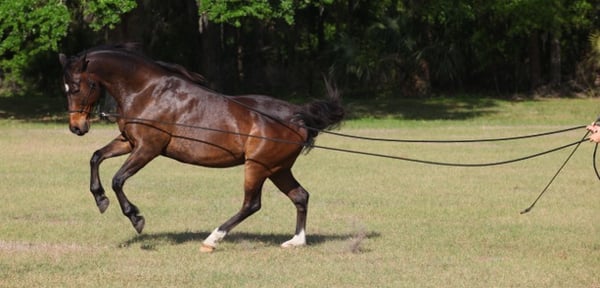
Lack of motivation is not just about a horse being ‘lazy’ or low energy, although there is some overlap in how to address it. (For a blog with video on how to train low energy horses, click here). Motivation is about inspiring your horse to use his energy to do what you are asking.
Motivation
Motivation simply means “a willingness to do something,” or, “the desire to act a certain way to reach a goal.” So why is it sometimes so challenging for us to get our horses to act a certain way or be a willing partner? Motivating your horse gets tricky because he may not share the same goals regarding training or performing specific movements that you hold. Many horses that are doing dressage don’t wake up thinking: ‘I hope we practice half passes today!’ but that doesn’t mean they can’t be trained in a way that builds a desire to perform with pride!
Could it be possible to motivate your horse in a positive way that also builds a partnership in which you and your horse both enjoy what you’re doing? The answer is yes!
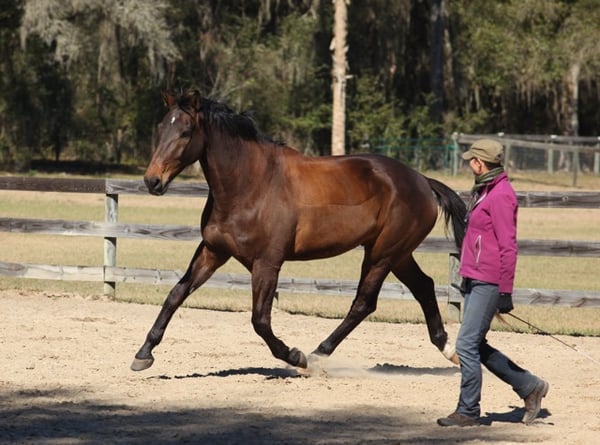
Why do horses do what we ask them to do?
- It’s better than the alternative. ‘Do it or else’ (The “gun to the head” approach to training)
- Obligingness (‘Because I said so’)
- Herd momentum (Other horses are doing it)
- Incentive (The horse knows he gets “paid” really well for doing it)
- Playfulness (Your horse thinks it’s fun to do what you asked)
Hopefully when you are looking for ways to motivate your horse to do what you ask of him, and to do it with effort and with pride, you won’t choose the “gun to the head” technique. There are moments in any type of training when you might have to use the “because I said so” approach because it’s necessary to keep your horse and yourself safe in certain circumstances.
It’s most ideal when your horse works with you in a learning environment because he feels like what you’re doing is “fun,” or because “he loves to do this sort of thing.” Even if he doesn’t naturally prefer to do what you want to do, learning how to ‘pay horses well’ can create an internal desire that can be very motivating to horses; and you can train them to want to answer your questions and do what you ask because they know they will be rewarded.
Make it Fun
While I know it’s necessary to be in control of the riding and training experience, my ultimate desire is to have my horses also enjoy themselves in the process. I want my horses to feel like it’s a cool deal for them. I don’t celebrate days where I had to use ALL my aids and ALL my strength to ride… I celebrate when it feels like the horse is offering and reading my mind! My goal is always to find ways to “pay” them well enough so they find some fun in what they’re doing and are agreeable to doing it again the next day..
It’s complicated by the fact that horses have different personalities, work ethics, and play drives. This means that it’s going to be easier for some horses to find fun and take pride in training than it will be for others.
If the horse’s personality is open to suggestion, or if what we are asking the horse to do at least sort of matches what he thinks is fun or interesting, it obviously becomes easier to motivate this horse to put effort into an exercise. On the other hand, we have all met horses where we have thought: ‘Ugh, this is never going to work with this horse.’ Not all of us can just run out and get another horse…we have to make the best with what we have.
Figuring out how to motivate individual horses is actually fun and interesting to me. I’ve had some amazing results turning horses around from closed and blocked to motivated and proud. Many times the problem is not the horse but that the motivation has been trained out of them, so it can be trained back in. Occasionally, there are horses who just inherently tend to say ‘No’ first and ask questions later. Most of the time, if you are clever and prioritize developing your motivational skills, this CAN be improved!
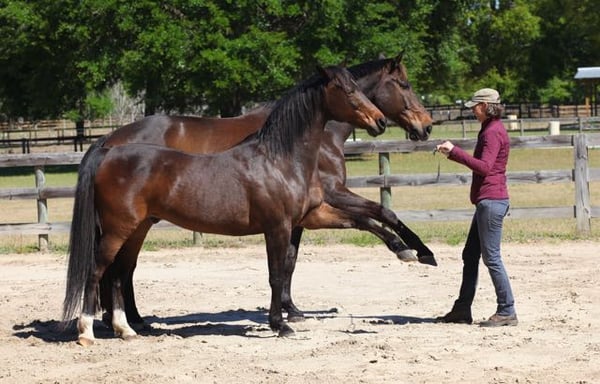
Using What Already Works
My discipline and my primary focus with my horses is dressage; however, I also do what I call “Silly Horse Tricks.” Let me tell you about how I motivated a horse that wasn’t the type I thought would be open to dressage at all, Solana. From the beginning, she wasn’t particularly open to suggestions. She was quite strong willed, and her natural response to being asked to go was to stop! …hmmmmm.
What I noticed is that when I asked her to perform ‘silly horse tricks,’ like put your foot in a tub, or go jump the barrel, or push this with your nose, or turn your lip up and smile, she became highly motivated and enthusiastic. So much so that she would actually push other horses out of the way to show off her silly horse trick prowess.
The way she acted doing tricks was in stark contrast to how some would describe her under saddle: stubborn, blocked, and unmotivated. So I decided to figure out how to get her to show the same enthusiasm during our dressage exercises that she showed doing silly horse tricks. What was it about the tricks that was different from the dressage lessons? How could I bring whatever I was doing during trick training into her dressage training experiences?
How To Make Dressage Fun
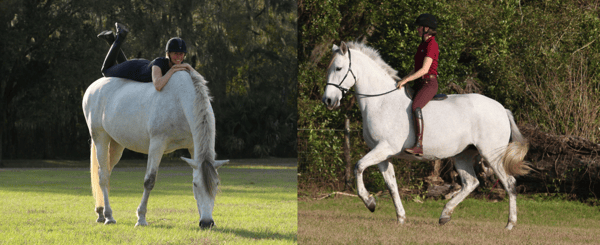
Be Light-hearted
Much of the difference in what happened during both these types of training experiences came from within me. Even when I was talking about the silly horse tricks, I was more light-hearted. My voice was higher, I smiled, I was relaxed, and all I was thinking about was doing something silly and enjoyable with Solana. There wasn’t internal pressure because I have no serious goals around these tricks.
I am pretty light-hearted with my dressage training too, but admittedly I am more ‘serious’ than when doing tricks. I found when working on dressage exercises with Solana I would become more intense, sometimes judgmental, and I felt more of a sense of pressure to accomplish my goals. Training results tended to “matter” to me more than the silly horse tricks.
I needed to find another layer of light-heartedness in my dressage while still being committed to getting results!
Isolate and Take Breaks
In dressage training there is a lot of moving around. Terms like flow, being in the zone, and loosening up are used. Linking movements and patterns together is important. Most dressage sessions consist of ongoing movement and flow throughout the entire lesson. The horse is required to maintain focus and to keep moving until the conclusion of the ride.
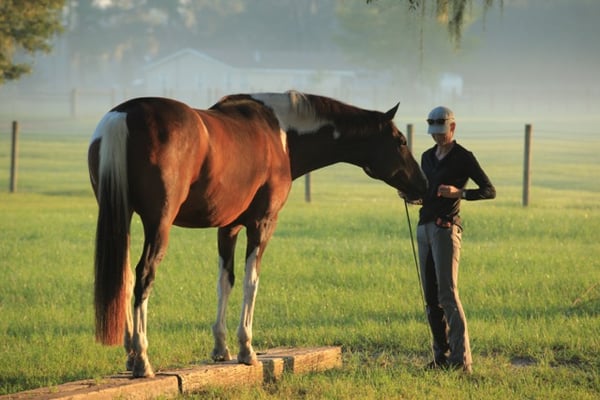
When doing silly horse tricks, the trick is usually an “isolated action.” Tricks focus on doing one specific thing at a time and getting one outcome. There is nothing, then a trick, a reward, then nothing again. The horse knows exactly when he’s done what you want because the “asking” stops immediately and he receives a reward. This kind of scenario tends to sensitize horses to the requests and they realize that immediate full commitment to doing what is asked quickly leads to rest and reward. Even the lowest energy horse will work hard for a moment if he knows it will lead to more rest!
Be Clear
When doing tricks, the horse knows whether or not he’s reached the desired goal. The hoof is either in the tub or it’s not; either he’s jumped the barrel or he hasn’t. So the horse has a way to measure whatever the behavior is that comes before the asking stops and the reward is given. That clarity motivates the horse to want to do more because he understands what the required outcome is. As a result, horses typically display a high degree of personal pride in their accomplishments and often offer tricks with a “see me” attitude.
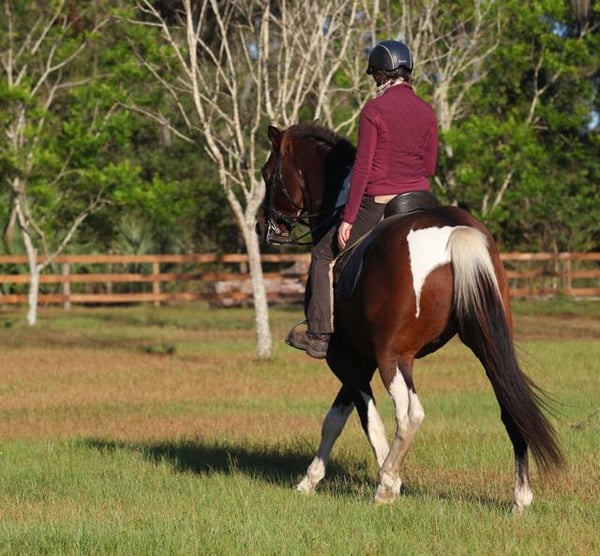
A great example of how precise a horse can be when he understands the desired outcome showed up for me when I was doing free jumping exercises with my horse Monty. While he was free jumping a pole in the arena, he hit the pole with his front feet the first time over, knocking the pole down. Then he took off around the arena as if to say, “let me at it,” seemingly determined to take the jump again. I barely got the pole into place before he gave it another try. This time he hit the pole with his back feet, knocking it down again. He bounded off on his own to try the jump once more. His next jump was perfect! Only then did he stop and come over to me. Of course he received a reward! And I might say he showed a great deal of personal pride attached to what he had done. The goal of this exercise (or trick) was very clear to him, and he was motivated to get it right before he quit trying.
In dressage training, there are certain aspects of the exercises that are inherently unclear to the horse. I am not sure if horses ever think: ‘Wow, I really nailed that bend in my half pass!’ in the same way the horse I told about above thought about clearing the jump. It’s critical to find ways to break exercises into pieces that become as clear as any silly horse trick.
Even if the horse doesn’t understand the “why” behind a particular movement (e.g., a counter change in hand at the half-pass, or more cadence in the trot), it’s important to demonstrate to him through our enthusiasm and encouragement (the reward) that his effort was on track.
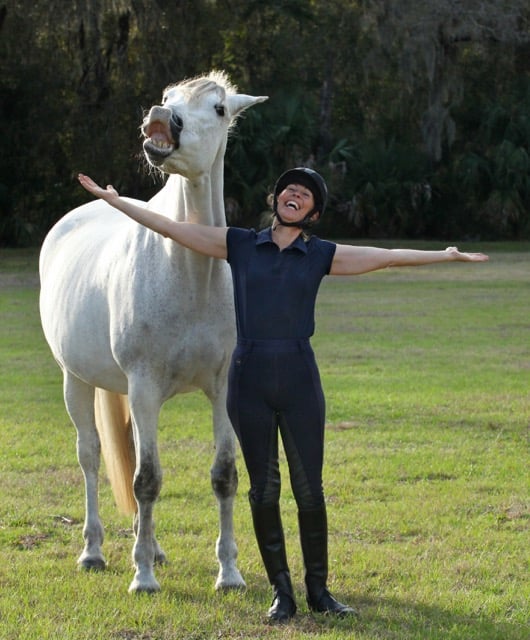
Horses pick up on our enthusiasm (when we show it), and they understand the connection between what they’ve done and our appreciation, especially when we show our approval with a reward. I really feel that they understand my voice, and if I start saying ‘yeah, yeah, yeah… GOOD!’ They do know that whatever it was they were just doing, I really liked it and they know they will be rewarded!
The horse just needs to know what success feels like so he’ll reach for it again. To stay motivated, your horse needs to understand that whatever he did, that was “it,” that’s what you wanted. Make it as clear as putting a hoof in a tub. Through repetition and practice he can come to understand exactly what aspect of what he was doing you liked.
Enjoy yourself and make it fun. If it’s fun for you, chances are your horse will sense that and he will have fun too.
Pay them Well
My horses understand when they’ve done something that I wanted because I pay them really well for their effort. I carry treats and reward them when they do something I like. I even have special treats for when I really really like what they’ve done. When they give me a really great effort or outcome, I give them what I call a jackpot - a lot of treats (lots of cookies, or pellets, or scratches, or whatever I’m using for a reward).
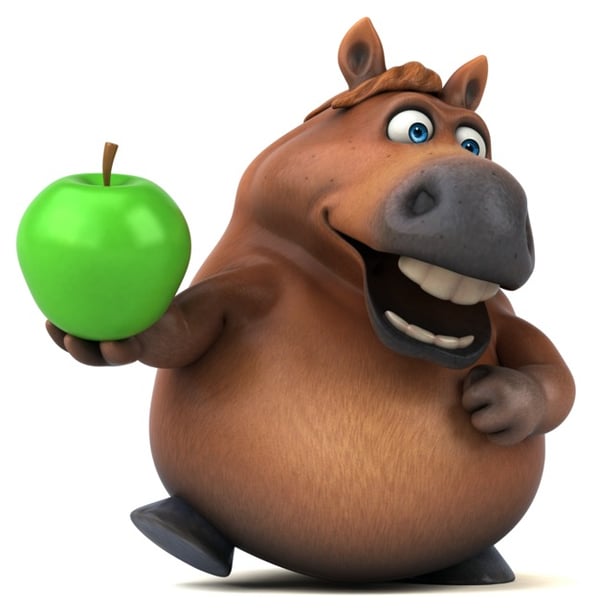
When I’m riding and feel the need to boost the horse’s enthusiasm for doing what I’m asking, I might even hide some special treats around the arena or outside riding area so I can dismount, take the tack off and surprise him with something really special. It’s like getting an unexpected bonus or someone showing up with chocolate chip cookies still warm from the oven… Your first question would likely be: ‘What did I do to deserve that?’ and that is exactly what I want my horses to be thinking!
Build Strength and Stamina
Dressage movements require exercises that build the horse’s strength, stamina, and coordination. You need to take the time to build the necessary physical skills that will make what you are asking feel easier to the horse. Think of creative ways to strengthen and build stamina in your horse, such as riding out on trails or in the field rather than just doing a million laps around a dressage arena.
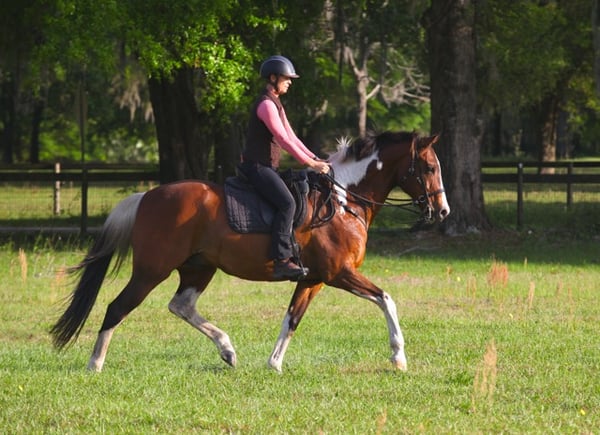
Keeping the horse motivated can get a bit more complicated because some movements won’t be easy or feel like fun until the horse gets stronger. You’re going to have to be an inspiring personal trainer for your horse in order to balance keeping him motivated with doing enough work to actually build strength and stamina.
Be Your Horse's Personal Trainer
It’s up to you to build a relationship that is strong and trusting enough so your horse will “push through” when you ask for it. I have had several personal trainers in my life for various activities and trust is absolutely vital. I have had trainers push me too hard and I trusted them but then injured myself. That lost trust was hard to win back. I have also had trainers that did a great job of keeping things interesting and who really were in the process with me, and they helped me reach goals I didn’t think I could.
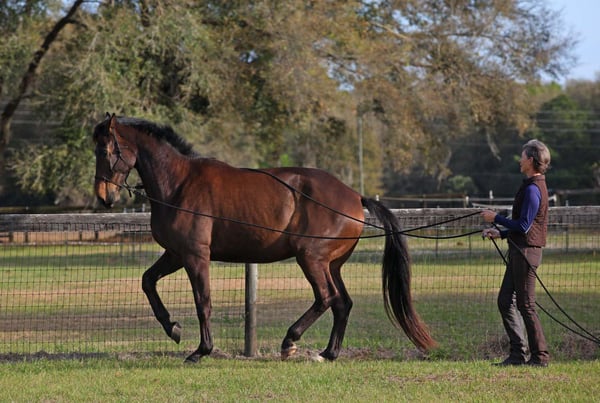
You want to be able to encourage your horse with a “come on….come on, just once more please” attitude while at the same time listening to your horse when he tells you he really can’t. If you push when he says he can’t and then he feels pain because of it, he will remember and will try harder to NOT do what you asked next time. It is an art to balance this delicate relationship.
Be Creative
One of the biggest mistakes we make in dressage training is drilling, and drilling, and drilling. You start and 45 minutes later you’re done. Rather than one long continuous session, turn it into 10 different small sessions. Breaking down your session this way makes it a much more powerful experience for your horse mentally, physically, and emotionally.
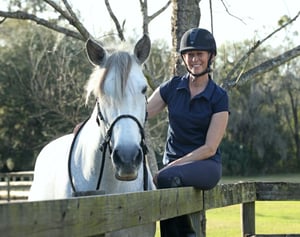
If you break exercises down into steps that are isolated and treat the movements like tricks, you make what you’re asking for clear to the horse. Even today when I work with Solana, we warm up and then we stop. (I’ve isolated the warm up). Then I plan the next part of the exercise; go down the long side of the arena, shoulder in and a 10 meter circle at E. Stop. Again, I’ve isolated a part of the exercise. Reward, tell your horse, “thank you very much. Now let’s do that again.” Stop and assess. When it’s really good, stop and reward with a jackpot! Show your enthusiasm. Possibly get off at this point or go on to do something else.
When you do stop, think about how you might make the movement better the next time. Allow your horse to stop. Give him time to think, catch his breath, and consider what he did just before the reward or treat. If he understands what he did just before receiving the reward, he’s more likely to try to duplicate it. Eventually you can string together longer patterns, building strength and stamina from things that are working well.
Being creative and having fun while discovering new ways to motivate your horse will transform your riding experiences!
More Resources
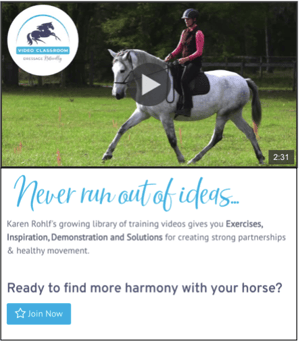 Since a happy horse is more easily motivated, you may enjoy the Happy Horse Interview Series.
Since a happy horse is more easily motivated, you may enjoy the Happy Horse Interview Series.
For those of you in the Video Classroom, look at the July 2020 video “Happy Horses, Common Threads,” Parts 1 and 2. In Part 2 there is a PDF chart you can download that includes a list of all the different things that my horses love. Remember that rewards don’t always have to be treats like pellets or cookies. The download offers you 60+ different creative ideas. You can also search under the Video Labels: Energy and Enthusiasm to find more videos on this subject!
Thoughts?
Scroll down to leave a comment!
